|
News Headlines Digest
June 2012
“Mysterious Structures Found in Syrian Desert”
Discovery News (USA)
“Ancient treasure found in Azerbaijan’s Aghsu region”
APA (Azerbaijan)
“Pre-Inca Cinnabar Mine Discovered in Trujillo”
Peruvian Times (Peru)
“The cinnabar used by the Moche to paint tattoos on their skin some 1,600 years ago may have been mined locally, according to recent findings by archaeologist Regulo Franco.
In 2006, Franco and his archaeology team at the El Brujo site on Peru’s north coast discovered the tomb of the Señora de Cao, a young mother who was obviously a ruler, buried around A.D. 400 in 26 layers of fine cloth and flanked by carved spears and clubs as signs of power.
From pots found in the tomb, she is believed to have died after childbirth, possibly from eclampsia.
One of the unique features was that, besides being magnificently decorated in glittering nose rings, crowns and necklaces, her skin was delicately tattooed with drawings of snakes, fish and other figures, which led to her nickname of the Tattooed Lady.”
[Full Story]
“Mysterious Building — Older Than Pyramids?”
Discovery News (USA)
“New test from a Welsh cave confirms Britain’s oldest rock-art”
Stone Pages Archaeo News (Italy)
“Cow and woman found in Cambridgeshire Anglo-Saxon dig”
BBC News (UK)
“Bulgarian Archaeologists Find Ancient Thracian Cemetery on Highway Route”
Novinite (Bulgaria)
“Archaeologists Solve Mystery of Palmyra”
Sci-News (USA)
“King’s Lynn: Bronze Age burial pot find excites experts”
Lynn News (England)
“Pakistan: Buddha rock carving attacked by Taliban gets facelift”
Jagran Post (India)
“Guardians ransack ancient archaeological site”
UzNews (Uzbekistan)
“Bulgarian Archaeologists Stumble Upon Ancient Treasure in Sozopol”
Novinite (Bulgaria)
“Feds Seize Etruscan Jug at Toledo Museum of Art”
GalleristNY (USA)
“Archaeologist Finds Oldest Rock Art in Australia”
Sudan Vision (Sudan)
“An archaeologist says he found the oldest piece of rock art in Australia and one of the oldest in the world: an Aboriginal work created 28,000 years ago in an Outback cave.
The dating of one of the thousands of images in the Northern Territory rock shelter known as Nawarla Gabarnmang will be published in the next edition of the Journal of Archaeological Science.
University of Southern Queensland archaeologist Bryce Barker said Monday that he found the rock in June last year but only recently had it dated at New Zealand’s University of Waikato radiocarbon laboratory.”
[Full Story]
“Vietnamese archaeologists have doubts of 3,500-year toilet discovery”
VietNamNet Bridge (Viet Nam)
“Seventy Egyptian artefacts found in illegal possession are authenticated”
Ahram Online (Egypt)
“Mysterious Structure May Have Led to Ancient Artificial Island”
Live Science (USA)
“Massive Gold Trove Sparks Archeological Dispute”
Spiegel Online (Germany)
“Serbian archaeologists discover mammoth field containing at least five of the giant beasts”
Art Daily (USA)
“As crisis bites, illegal digs are on the rise”
eKathimerini (Greece)
“Roman coins find prompts dig to uncover Newton Abbot Roman settlement”
This Is South Devon (England)
“First Dairying in Sahara 7000 Years Ago”
Sci-News (USA)
“French cave paintings suggest ancient man was first cartoonist”
The Voice of Russia (Russia)
“French scientists have suggested a sensational hypothesis: according to archaeologist Marc Azéma from Toulouse University and artist Florent Rivère, prehistoric artists who painted on the walls of caves were the first animators.
Mark Azéma and Florent Rivère draw attention to the fact that the majority of petroglyphs depict animals in motion, and the researchers believe that the flickering light of the torches intended to create optical illusions for the audience.
They assert that their conclusions are based on the results of more than twenty years of study that have recently been systematized and published.”
[Full Story]
“Digging for tsunamis”
ABC Science News (Australia)
“Archaeology journal says burial box of Jesus’ brother is genuine”
Los Angeles Times (USA)
“Experts: terra cotta army was looted and burned”
China.org (China)
“Prehistoric crustaceans found in Lake Eyre”
ABC Bush Telegraph (Australia)
“Early Iron Age fashion from Denmark”
Past Horizons (UK)
“Luxor court sentences 11 people for stealing antiquities”
Egypt Independent (Egypt)
“Ancient cave art could be Neanderthal’s”
ABC Science News (Australia)
“German translates oldest known Hebrew”
The Local (Germany)
“Experts unearth new terracotta warriors”
Global Times (China)
“Experts have found more terracotta warriors and wares in a new round of archaeological excavation at the Emperor Qin Shihuang’s mausoleum, as well as evidence that the mausoleum was once set on fire, according to the site’s management authority.
The Museum of the Terracotta Warriors and Horses of Emperor Qin Shihuang (259-210 BC) announced on Saturday that in the third round of excavation, archaeologists found more than 310 relics at the northern part of the No.1 pit, including 120 terracotta figurines and 12 horses.
New findings have shown that each terracotta figurine has its own facial expression. In another finding, the terracotta armor on the figurine of a general had been produced more intricately than those of other figurines.”
[Full Story]
“Scientists are accused of distorting theory of human evolution by misdating bones”
The Guardian (UK)
“Part of Persepolis sewage system unearthed”
Payvand (Iran)
“Scientists excited about US mammoth discovery”
PhysOrg (USA)
“Archeological excavations in West Kazakhstan region”
CaspioNet (Kazakhstan)
“BYU students excavating Fremont Indian village in Goshen”
Daily Herald (USA)
“Arabian Gulf ‘has potential for discovery of ancient remains’”
Gulf Times (Qatar)
“Learning more about the Middle Kingdom”
Al-Ahram Weekly (Egypt)
“2 arrested in Greece with ancient wreath, armband”
The Jakarta Post (Indonesia)
“Trafficking In Antiquities During A Time Of War – Analysis”
EurAsia Review (Spain)
“Stoneage Artists Created Prehistoric Movies”
Discovery News (USA)
“Archaeologists look for wrecks off Qatar coast”
Gulf Times (Qatar)
“King Meneptah’s stelae in Silsila is safe after theft attempt”
Ahram Online (Egypt)
“Should Cambodian ‘blood antiquities’ be returned?”
CNN (USA)
“The last time most New Yorkers focused on pillaged antiquities from Cambodia was likely after the release of the Angelina Jolie film ‘Lara Croft: Tomb Raider’, which featured the heroine’s adventures through the country’s famous archaeological wonder, Angkor Wat.
Now, real ‘tomb raiding’ is making the news as the Cambodian government seeks to recover antiquities allegedly plundered from the kingdom’s ancient sites during its civil war, ethnic cleansing and foreign occupation.
At Cambodia’s request, the United States recently filed suit in U.S. District Court against Sotheby’s in New York, demanding that the auction house forfeit a sandstone warrior that was ‘illicitly removed’, according to the complaint, from a remote jungle temple.”
[Full Story]
“Israeli archaeologists find ancient Roman treasure”
Ha’aretz (Israel)
“Are you sure digging him up is a good idea? Vampire found with iron rod staked through chest!”
Malaysia Chronicle (Malaysia)
“Ship’s exotic cargo may be pirates’ haul”
Irish Times (Ireland)
“When you’re in a hole, stop digging!”
The Jerusalem Post (Israel)
“Archaeologists in Oban discover Bronze Age was height of cool”
The Scotsman (Scotland)
“Six ancient kilns discovered in north China”
XinhuaNet (China)
“Sierra Nevada 200-Year Megadroughts Confirmed”
Science Daily (USA)
“Oldest musical instruments discovered”
Cherwell Online (England)
“1,600-year-old mosaic at synagogue damaged”
The Times & Democrat (USA)
“Maya mural found: Refutes world’s end on 12/21/12”
IT-Wire (Australia)
“Iberia’s oldest Jewish artefact unearthed in Messines”
The Portugal News Online (Portugal)
“A team of German archaeologists unearthed an artefact believed to be the earliest known evidence of the Jewish culture un the Iberian Peninsular during an excavation in S.B. Messines, Silves.
The team from the University of Friedrich-Schiller in Jena, Germany found a marble plaque measuring 40cm by 60cm with the name ‘Yehiel’ inscribed as well as other letters that have not yet been deciphered. It is believed the artefact could be a funerary stone.
Radiocarbon dating of deer horns found next to the stone artefact gives a date of no later than 390AD.”
[Full Story]
“Elizabethan ship to be laid to rest in Stoney Cove”
The Hinckley Times (England)
“Burial site revealing ancient Egyptian funerary rites uncovered”
Ahram Online (Egypt)
“Veterans learn valuable job skills curating archaeological finds in north Old Town”
Alexandria Times (USA)
“Local communities help discover new Australian dinosaurs”
ABC Radio News – The Science Show (Australia)
“James ossuary collector sentenced to month in jail”
The Jerusalem Post (Israel)
“Stolen Pharaonic statue pieces seized in Giza”
Egypt Independent (Egypt)
“Guildhall event uncovers the story of largest Anglo-Saxon gold find”
This Is Bath (England)
“Ancient Egyptian Husband and Wife to Be Re-united at Brussels Ancient Art Fair”
San Fransisco Chronicle (USA)
“The Antikythera Mechanism Research Project”
Cardiff/Athens Universites (Cymru/Greece)
[In October 1900, Captain Dimitrious Kondos was leading a team of sponge divers near the the island of Antikythera off the coast of Greece. They noticed a shipwreck about 180 feet below the surface and began to investigate. Amongst the artifacts that they brought up was a coral-encrusted piece of metal that later archaeologists found was some sort of gear wheel.
The rest of the artifacts, along with the shape of the boat, suggested a date around 2000 years ago, which made the find one of the most anomalous that had ever been recovered from the Greek seas. It became known as The Antikythera Mechanism.
In 2006 the journal “Nature” published a letter, and another paper about the mechanism was published in 2008, detailing the findings of Prof. Mike G. Edmunds of Cardiff University. Using high-resolution X-ray tomography to study the fragments of the anomalous Antikythera Mechanism, they found that it was in fact a bronze mechanical analog computer that could be used to calculate the astronomical positions and various cycles of the Moon – as seen from the Earth: – Ed]
Part of the Antikythera Mechanism
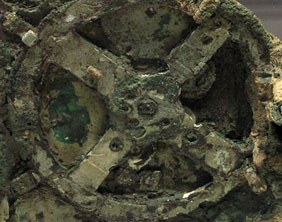
Copyright © 2006
Antikythera Mechanism Research Project
“Antikythera Mechanism – World’s earliest existing analogue computer”
HotnHit News (India)
“Decoding an Ancient Computer: Greek Technology Tracked the Heavens”
Scientific American (USA)
“Watch a video explaining the Antikythera mechanism”
Nature (UK)
“World’s First Computer Rebuilt, Rebooted After 2,000 Years”
Wired Gadget Lab (USA)
“Antikythera: A 2,000-year-old Greek computer comes back to life”
The Guardian Science Blog (UK)
Google image search results for The Antikythera mechanism
Google (USA)
|
“Decoding the Heavens:
Solving the Mystery of the World’s First Computer”
by
Jo Marchant
William Heinemann Ltd
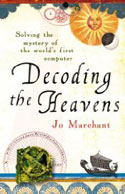
Get This Book From:
Amazon.com
Amazon.co.uk
“For more than a century this ‘Antikythera mechanism’ puzzled academics, but now, more than 2000 years after the device was lost at sea, scientists have pieced together its intricate workings.”
“Ancient Greek Computer from Rhodes: Known as the Antikythera Mechanism”
by
V. J. Kean
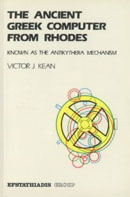
Get This Book From:
Amazon.com
Amazon.co.uk
“This is the true history of an astonishing machine during the time when the island of Rhodes was the centre of both cultural and intellectual activity within the Roman Empire.
Made on the island of Rhodes around 71BC, the computer was lost beneath the waves for almost 2000 years.”
“Gears from the Greeks: The Antikythera Mechanism, a Calendar Computer from Ca 80 B.C.”
by
Derek de Solla Price
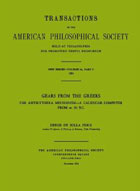
Get This Book From:
Amazon.com
Amazon.co.uk
“The first great discovery in underwater archaeology yielded not only a fine collection of art treasures but also the most enigmatic, most complicated piece of scientific machinery known from antiquity.”
“The Works of Archimedes”
by
Archimedes
(Author)
&
Sir Thomas Heath
(Translator)
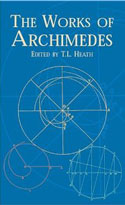
Get This Book From:
Amazon.com
Amazon.co.uk
“The complete works of antiquity’s great geometer appear here in a highly accessible English translation by a distinguished scholar.
Remarkable for his range of thought and his mastery of treatment, Archimedes addressed such topics as the famous problems of the ratio of the areas of a cylinder and an inscribed sphere; the measurement of a circle; the properties of conoids, spheroids, and spirals; and the quadrature of the parabola.
This edition offers an informative introduction with many valuable insights into the ancient mathematician’s life and thought as well as the views of his contemporaries. Modern mathematicians, physicists, science historians, and logicians will find this volume a source of timeless fascination. Unabridged reprint of the classic 1897 edition, with supplement of 1912.”
“Circumference: Eratosthenes and the Ancient Quest to Measure the Globe”
by
Nicholas Nicastro
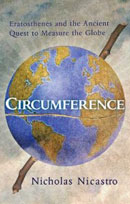
Get This Book From:
Amazon.com
Amazon.co.uk
“Forget the myth of Columbus’ daring in imagining a round earth. Nicastro not only traces the conception of a spherical world back more than a millennium before the seafarer set sail but also recounts in fascinating detail how the ancient Greek geometer Eratosthenes measured that sphere with astonishing accuracy.”
Though it would be thousands of years before his feat received appropriate recognition, Eratosthenes conducted his revolutionary science with nothing more complex than a sundial and a compass.
With reader-friendly clarity, Nicastro explains the surprisingly simple calculations behind the earth measurement. But readers learn about much more than geodesy: Nicastro delivers the deeply human story of a multitalented genius whose tenure as the head of Alexandria’s famed library occasioned remarkable achievements in literature, history, linguistics, and philosophy despite the political turmoil that periodically rocked the Ptolemaic world.”
|







